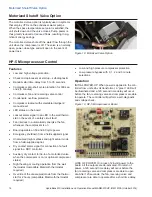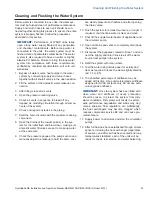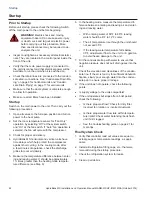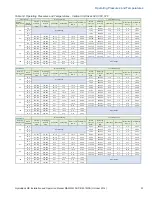
26
HydroBank MS Installation and Operation Manual MAMM-WSHP-IOM-1MSA (October 2014)
Troubleshooting
Troubleshooting
Charts in this section provide general guidelines for
troubleshooting problems with your unit. For additional
help, contact your local Mammoth representative. For
assistance locating your Mammoth representative, visit
www.mammoth-inc.com.
Table 4: Refrigeration System Troubleshooting
Symptom
Head
Pressure
Suction
Pressure
Compressor
Amp Draw
Super Heat
Subcooling
Air Temp
Differential
Water
Loop Temp
Differential
Safety Lockout
Undercharged system
Low
Low
Low
High
Low
Low
Low
Low Pressure
Overcharged system
High
High or Normal
High
Normal
High
Normal
Normal
High Pressure
Low air flow in cooling
Normal
Low
Low or Normal
Low or Normal
Normal
High
Low or Normal
Low Temp
Low water flow in cooling
High
High or Normal
High
High or Normal
Normal
Normal or Low
High
High Pressure
High air flow in cooling
Normal
or Low
High
Normal
High
Low
Low
Normal
High Pressure or
No Lockout
High water flow in cooling
Low
Normal
Low
Normal
Normal
Normal
Low
Low Temp or
No Lockout
TVX restricted
High
Low
Normal or low
High
High
Low
Low
High Pressure
Table 5: Performance Troubleshooting
Problem
Heating Cooling Possible Cause
Solution
Insufficient
capacity
X
X
Dirty air filter
Replace or clean.
X
X
Low refrigerant charge
Recover refrigerant and re-charge to nameplate.
Not cooling or
heating properly
X
X
Reduced or no air flow
Check for dirty air filter; clean or replace. Check fan motor operation, airflow restrictions.
X
X
Low refrigerant charge
Recover refrigerant and re-charge to nameplate.
X
X
Low water flow
Adjust to proper water flow rate
X
X
Leaky duct work
Check supply and return air temperatures at the unit and at distant duct registers. If
significantly different, check for duct leaks.
Unit doesn’t
operate in
cooling
X
X
Low refrigerant charge
Recover refrigerant and re-charge to nameplate.
X
X
Restricted metering device
Check superheat and subcooling. Replace metering device.
X
Defective reversing valve
Perform reversing valve touch test.
X
X
Thermostat improperly located
Check thermostat location and for air drafts behind thermostat.
X
X
Scaling in waterside heat exchanger
Perform scaling check and clean if necessary.
X
X
Inlet water too hot or cold
Check inlet water temperature. Check loop system for proper operation/design.
High head
pressure
X
Reduced or no air flow in heating
Check for dirty air filter; clean or replace. Check fan motor operation, airflow restrictions.
X
Reduced or no water flow in cooling
Check pump operation or valve operation/setting. Check water flow; adjust to proper flow rate.
X
Inlet water too hot
Check inlet water temperature. Check loop system for proper operation/design.
X
Air temperature out of range in heating
Bring return air temp within design parameters.
X
Scaling in waterside heat exchanger
Perform scaling check and clean if necessary.
X
X
Unit overcharged
Check superheat and subcooling.
X
X
Non-condensable in system
Vacuum system, reweigh in charge.
Low suction
pressure
X
Reduced water flow in heating
Check pump operation or valve operation/setting. Check water flow; adjust to proper flow rate.
X
Water temperature out of range
Bring water temp within design parameters.
X
Reduced air flow in cooling
Check for dirty air filter; clean or replace. Check fan motor operation, airflow restrictions.
X
Air temperature out of range
Check for too much cold vent air. Bring entering air temp within design parameters.
X
X
Low refrigerant charge
Recover refrigerant and re-charge to nameplate.
Low discharge
temp in heating
X
Too high of air flow
Check fan motor speed selection and airflow.
X
Dirty air filter restricting air flow to space Replace or clean.
















































